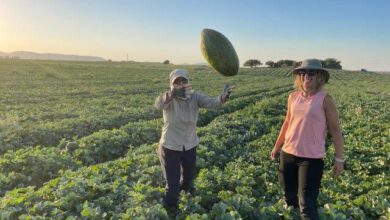Curcumin: developing a novel "green" food preservative from the old yellow spice
The microbial contamination of food has two major negative consequences
Victor Rodov vrodov@agri.gov.il

Victor Rodov*1, Esther Mwangi1,2, Ilya Shlar1,2, Batia Horev1, Yakov Vinokur1, Samir Droby1
Why do we need “green” food preservatives?
The microbial contamination of food has two major negative consequences. Microorganisms are the most common cause of food spoilage resulting in a wastage of approximately one-third of the foods produced in the world. On the other hand, potential presence of human pathogens in the food poses a health hazard, annually causing about 420,000 deaths worldwide due to foodborne diseases. Thus, various preservation methods have been used to control the food contamination. Refrigeration has been the basis of the cold chain supply, but alone it cannot ensure the quality and safety of foods due to the presence of cold-resistant psychrotrophic microorganisms.
Additional preservation means including thermal processing such as pasteurization and the use of chemical preservatives and sanitizers. However, these practices affect nutritional and organoleptic characteristics of the food, and leave undesirable toxic residues and are not popular with modern health-aware consumers. The food industry is eager to find additional safe and effective consumer-friendly environment- and product-friendly preservation techniques based on natural antimicrobial food grade agents. Antimicrobial extracts originating from spices and herbs are of considerable interest as potential sources of such “green” preservatives.
Curcumin: from Vedic scriptures to cutting-edge scientific papers
Curcumin is an antimicrobial agent addressing the above key demands. It is a bright-yellow natural polyphenolic compound, the major active constituent of turmeric, a spice prepared from dried ground rhizomes of Curcuma longa L. (Figure 1). Turmeric has been an integral part of India’s cultural and culinary heritage for thousands of years. Historical evidence says that turmeric was first cultivated in India as early as about 3000 B.C., and for the first time its medicinal potential was documented in 250 B.C. It has been highly valued by Eastern medicinal systems, including Ayurveda and traditional Chinese medicine for its healing properties for wounds, ulcers, skin diseases, inflammations, etc. Nowadays, extensive research confirms that curcumin possesses various health-beneficial activities: anticancer, anti-inflammatory, antimicrobial, etc. The number of scientific papers dealing with curcumin has increased from 100-150 publications per year in the first half of the 1980-ies to above 21,000 in 2017.
.jpg)
Figure 1. Turmeric and the molecular structure of curcumin
In our previous research, curcumin showed by far the highest antibacterial potency among the range of phenolic compounds tested. The combination of high antimicrobial activity with a status of registered food additive and GRAS (generally recognized as safe) compound, makes curcumin an attractive candidate for developing a new generation of “green” food preservatives. Our work aims at finding ways to realization of this potential in order to control the microbial food spoilage and prevent the health risks associated with foodborne human pathogens.
Curcumin-Cyclodextrin: a winning pair
However, poor aqueous solubility of curcumin poses an obstacle for exploiting its bioactivity. In our work, we used cyclodextrins for enhancing the water solubility of curcumin. Cyclodextrins are GRAS compounds, cyclic oligosaccharides produced from starch. They have a hydrophilic (attracted to water) outer surface and a hydrophobic (water-repelled) inner cavity. Thus, cyclodextrins can form water-soluble inclusion complexes with hydrophobic compounds like curcumin, providing them “a buoy vest” in aqueous medium (Figure 2). In particular, methyl--cyclodextrin is effective in preparing water-miscible curcumin formulations and delivering its activity to bacterial cells.
.jpg)
Figure 2. Self-assembly of curcumin-methyl-β-cyclodextrin inclusion complex (CCD)
Curcumin-cyclodextrin (CCD) inclusion complex exhibited a potent antimicrobial effect. Furthermore, illumination with blue light significantly increased the bactericidal efficacy of CCD. Exposure of Escherichia coli under the blue light to curcumin concentration as small as 0.12 mM (0.04 mg curcumin per milliliter of aqueous CCD solution) resulted in complete disappearance of viable bacteria within just 1.5 h (Figure 3A-B). The light-dependent antimicrobial effect of CCD was associated with the production of reactive oxygen species (ROS) that led to bacterial death (Figure 3D). Curcumin effect was evident under both refrigerated and non-refrigerated conditions (Figure 3C).
.jpg)
Figure 3. Effect of curcumin concentration on the viability of E. coli (A) (from Shlar et al., 2017, RSC Advances, 7: 42559-42569), under the blue light (B). Antimicrobial effect of curcumin under refrigerated and non-refrigerated conditions (C). Photodynamic curcumin effect scheme (D).
Testing the applications
The preservative efficacy of curcumin-cyclodextrin complex was tested with freshly prepared carrot juice – a food model prone to microbial spoilage. Keeping the unpasteurized juice for one day at 20°C resulted in a 3-log (thousand-fold) increase of microbial counts. Even under the refrigerated conditions, the microbial count of such juice increased tenfold (Figure 4). Adding curcumin (0.4 mM) in the form of CCD prevented the microbial proliferation in the juice at 20°C. Moreover, combination of curcumin and refrigeration resulted in the decline of microbial count, i.e. after one day of storage in the refrigerator, the microbiological quality of the curcumin-added juice was better than immediately after squeezing (Figure 4). Yeast and mold growth in the juice were also controlled by CCD.
.jpg) | .jpg) |
Figure 4. Testing the carrot juice (a); effect of curcumin-cyclodextrin complex on total microbial counts of non-pasteurized carrot juice after 24 h of storage at 20 or 4°C (b);
In addition to preparing aqueous curcumin-based preservative formulations, our work included developing curcumin-based antimicrobial food-contact surfaces. Various mechanisms were used for attaching curcumin to the surface of plastic materials and glass, e.g., covalent binding, ultrasound-driven deposition, electrostatic interaction. In the dark, the curcumin-coated cross-linked surfaces showed lower antimicrobial activity than aqueous CCD solutions. On the other hand, curcumin-coated surfaces maintained their light-induced bactericidal activity based on ROS production. The potency of such surfaces did not decline even after three days of water soaking. As a result, upon illumination the curcumin coating inhibited bacterial attachment to working surfaces and the microbial transfer (cross-contamination) from contaminated substrate to foods. Interestingly, some types of these active coatings may allow repeated curcumin loading. Thus, our findings show that the antimicrobial potential of curcumin can provide various novel “green” solutions for reducing microbial food spoilage and controlling the spread of foodborne diseases.
1) Agricultural Research Organization, the Volcani Center, Israel; 2) The Robert H. Smith Faculty of Agriculture, Food and Environment, Hebrew University of Jerusalem, Israel




